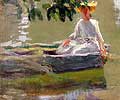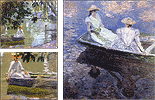The boating theme evolution
We have found out how Monet has turned the boat around in the
River-Scene and we are now seeing the boat passing by on the river,
gliding out of sight…. Here it is of particular interest to study
this stage of the evolution link. We again remember the first sketch
with the cut boat and the girl ’indicated’ and with her hand on the
right oar. Today she is not indicated any longer – we proceed
another step forward – we can only see the oar and we have to
imagine her being there – at the oars, out of our sight. In short:
Impressionism. And even shorter: Monet…

Click for larger picture
It certainly is exciting to follow Monet in his everlasting
struggle exploring new territory. We have studied the different
stages of development in the sketches and especially in the River
Scene. We can almost look upon the process as a long pregnancy.
Two paintings were ’born’ closely related to these sketches and
the River-Scene.
It is hard to say which of these two came first. In ’The Blue
Barque’ the boat is lying close to the bank, like we have seen in
the x-ray and the infra-red photo, revealing the first state of the
River-Scene.
|

Click
HERE for a comparison |
The girls are two of Suzanne's sisters. Marthe Hoschedé is
sitting in the stern, the other is Blanche Hoschedé-Monet. We can
see some sun-splashes and it is evident that the boat is lying in
the shadow from the trees above and behind us, filtering the early
morning light. See also the reflected sun-glitter on the side of the
boat. Small, but important details, creating the Monet impression of
light.
|


Click
HERE for a comparison |
Now it is Suzanne that is sitting in the stern. Blanche is still
sitting turned away from us but now with her hands on the gun-wale
in the typical Monet-way with the ’looking-through’ 3D-effect.
Claude Monet also paints Suzanne in the same ’open’ way, so that we
can catch a glimpse of her hair under her right arm. Even the left
arm is painted so we can see a glimpse of the water behind.
Look at the River Scene and you will find the same
manner of treating the model. We get a glimpse of the water under
both arms. Nothing done at random here.
|

Click
HERE for a comparison with some other paintings with
girls sitting in a similar way. |

Please click for detail comparison.
The girls are now reflected in the water. The light is still
filtered through the foliage but more light is giving sharper
contrasting effects. The shadow from the boat in this painting as
well as in ’The Blue Barque’ is very similar to the shadow in the
River Scene as it looks today, as well as in the first state. In the
sketches we have seen Monet mirroring the girls in the water.
In ”Young Women in Boat” we can see this idea being accomplished.
The girls are reflected in the water.
|

Click
HERE for shadow from the boat comparison. |
|

Please click
HERE for a repeated comparison. |
It is interesting to see that in both of these paintings the boat
is cut by the right hand margin. We know that Monet is reading his
paintings from left to right. Apparently we have the boats turned in
this way – to the right. The thwart is an effective resistance for
our eyes to slip out of the picture.
Monet finally choses not to paint any oars in these two pictures.
Mainly probably because of understandable difficulties with the
composition, and certainly also because of problems to get it look
natural with the oars vanishing down into the water. When we look at
other paintings, there are a lot of boats with people rowing, mainly
in the earlier production, though mostly as small staffage. Most of
them have the oars lifted over the water. So also the two Canot
paintings from around 1890. These two are the very last of the
Boating Girls series.
|

Click
HERE to see "La Barque rose", (Collection M.Riklis, USA)
and "The Empty Boat" |
Here Monet is looking down into the water, painting the moving
see-weed, like he had done in ’The Empty Boat’.
Press HERE for next
page
|